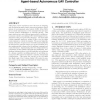Free Online Productivity Tools
i2Speak
i2Symbol
i2OCR
iTex2Img
iWeb2Print
iWeb2Shot
i2Type
iPdf2Split
iPdf2Merge
i2Bopomofo
i2Arabic
i2Style
i2Image
i2PDF
iLatex2Rtf
Sci2ools
ATAL
2005
Springer
2005
Springer
Experiences with the design and implementation of an agent-based autonomous UAV controller
This paper reports experiences and outcomes of designing and developing an agent–based, autonomous mission control system for an unmanned aerial vehicle (UAV). Most UAVs are not truly autonomous or even unmanned but are more correctly termed ‘uninhabited’ or ‘remotely piloted’. This paper explores two quite different approaches for adding autonomous control to an existing UAV. Both designs were implemented using an agent–based language. The first takes a fairly standard approach, adding a layer over the flight control system to control the mission. The second takes the human metaphor of agency more seriously and implements an autonomous controller based on a model of human decision making widely referenced in the military command and control literature. Implementing these two designs allowed a comparison of their relative strengths and weaknesses. Preliminary findings indicate both the feasibility and usefulness of a human cognitive modelling approach to providing auto...
Related Content
| Added | 26 Jun 2010 |
| Updated | 26 Jun 2010 |
| Type | Conference |
| Year | 2005 |
| Where | ATAL |
| Authors | Samin Karim, Clinton Heinze |
Comments (0)

